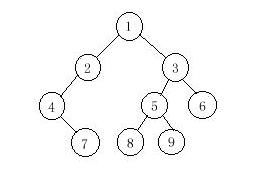Description
A binary tree is a finite set of vertices that is either empty or consists of a root r and two disjoint binary trees called the left and right subtrees. There are three most important ways in which the vertices of a binary tree can be systematically traversed or ordered. They are preorder, inorder and postorder. Let T be a binary tree with root r and subtrees T1,T2.
In a preorder traversal of the vertices of T, we visit the root r followed by visiting the vertices of T1 in preorder, then the vertices of T2 in preorder.
In an inorder traversal of the vertices of T, we visit the vertices of T1 in inorder, then the root r, followed by the vertices of T2 in inorder.
In a postorder traversal of the vertices of T, we visit the vertices of T1 in postorder, then the vertices of T2 in postorder and finally we visit r.
Now you are given the preorder sequence and inorder sequence of a certain binary tree. Try to find out its postorder sequence.

In a preorder traversal of the vertices of T, we visit the root r followed by visiting the vertices of T1 in preorder, then the vertices of T2 in preorder.
In an inorder traversal of the vertices of T, we visit the vertices of T1 in inorder, then the root r, followed by the vertices of T2 in inorder.
In a postorder traversal of the vertices of T, we visit the vertices of T1 in postorder, then the vertices of T2 in postorder and finally we visit r.
Now you are given the preorder sequence and inorder sequence of a certain binary tree. Try to find out its postorder sequence.

Input
The
input contains several test cases. The first line of each test case
contains a single integer n (1<=n<=1000), the number of vertices
of the binary tree. Followed by two lines, respectively indicating the
preorder sequence and inorder sequence. You can assume they are always
correspond to a exclusive binary tree.
Output
For each test case print a single line specifying the corresponding postorder sequence.
Sample Input
9
1 2 4 7 3 5 8 9 6
4 7 2 1 8 5 9 3 6
Sample Output
7 4 2 8 9 5 6 3 1
不知道为什么往函数里串地址就运行不了,找了半天没找到错误!
这是错误的代码:
#include <stdio.h>
#include <string.h>
int n;
int a[1000], b[1000], c[1000];
void build( int len, int s1, int s2, int s )
{
int p;
int i;
if(len<=0)
return;
else
{
for(i=s2; i<s2+len; i++ )
{
if(b[i]==a[s1])
{
p = i;
break;
}
}
c[s+len-1] = a[s1];
build(p, s1+1, s2, s ); //左
build(len-p-1, s1+p+1, s2+p+1, s+p); //右
}
}
int main()
{
int i, j;
while(scanf("%d", &n)!=EOF)
{
for(i=0; i<n; i++)
{
scanf("%d", &a[i] );
}
for(i=0; i<n; i++)
{
scanf("%d", &b[i] );
}
build(n, 0, 0, 0);
for(i=0; i<n; i++)
{
printf("*%d ", c[i] );
}
}
return 0;
}
这是正确的代码:
#include <stdio.h>
#include <string.h>
void build(int len, int *s1, int *s2, int *s)
{
int p;
int i;
if(len<=0)
return;
else
{
for(i=0; i<len; i++)
{
if(s2[i]==s1[0])
{
p = i;
}
}
build(p, s1+1, s2, s);
build(len-p-1, s1+p+1, s2+p+1, s+p);
s[len-1] = s1[0];
}
}
int main()
{
int i;
int s1[1000], s2[1000], s3[1000];
int n;
while(scanf("%d", &n)!=EOF)
{
for(i=0; i<n; i++)
{
scanf("%d", &s1[i] );
}
for(i=0; i<n; i++)
{
scanf("%d", &s2[i] );
}
build(n, s1, s2, s3 );
for(i=0; i<n; i++)
{
printf("%d%c", s3[i], i==n-1?'
':' ' );
}
}
return 0;
}